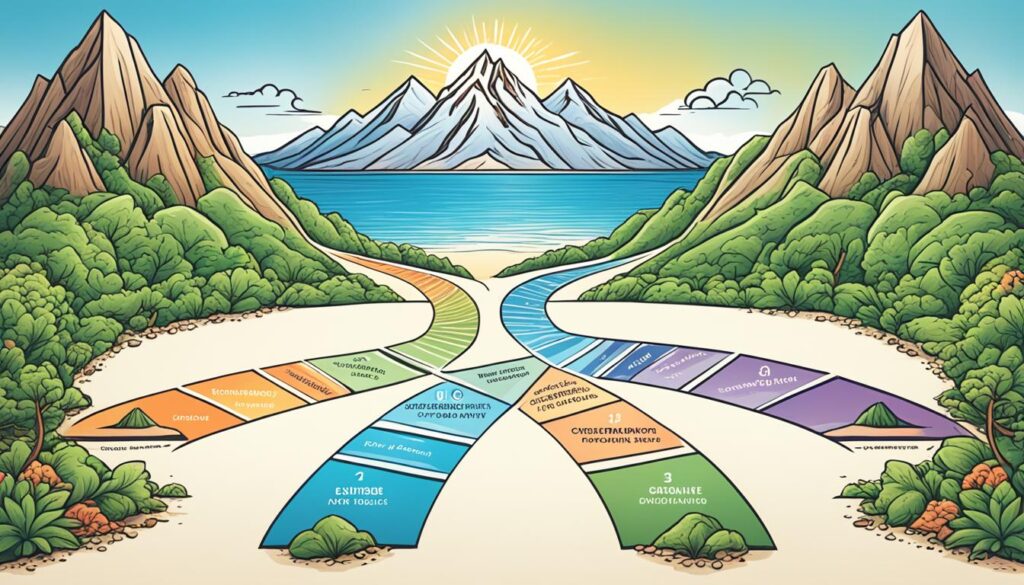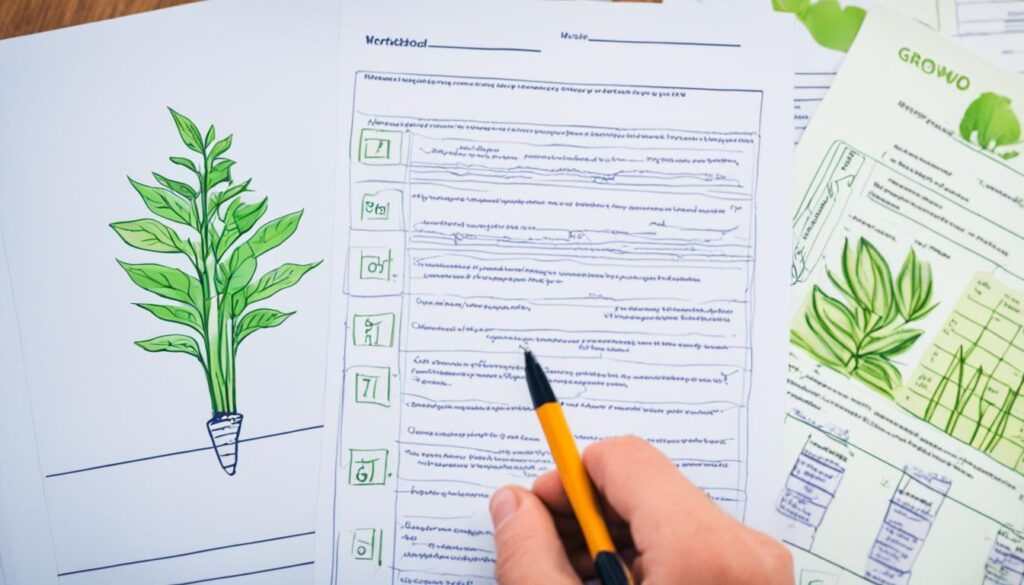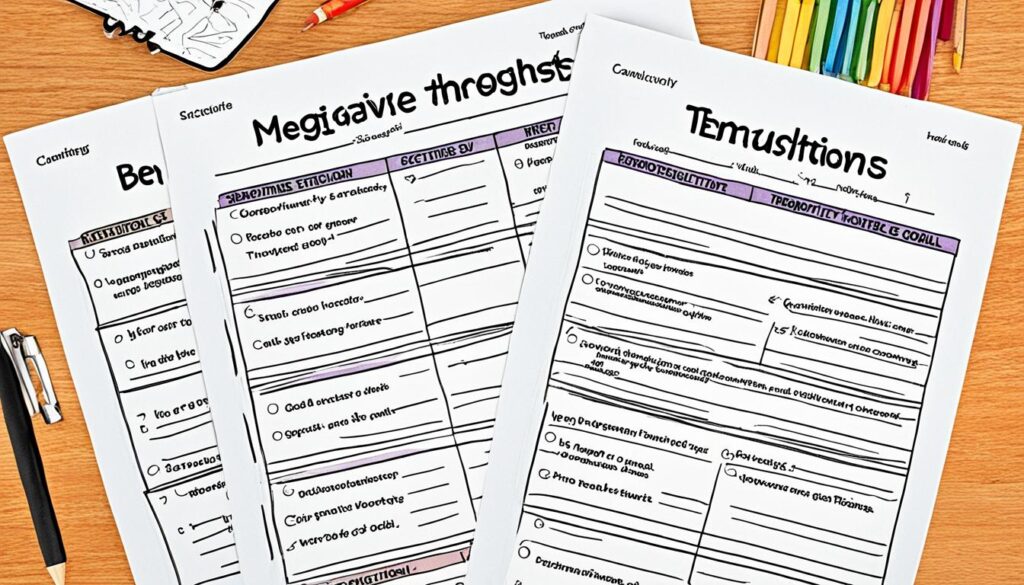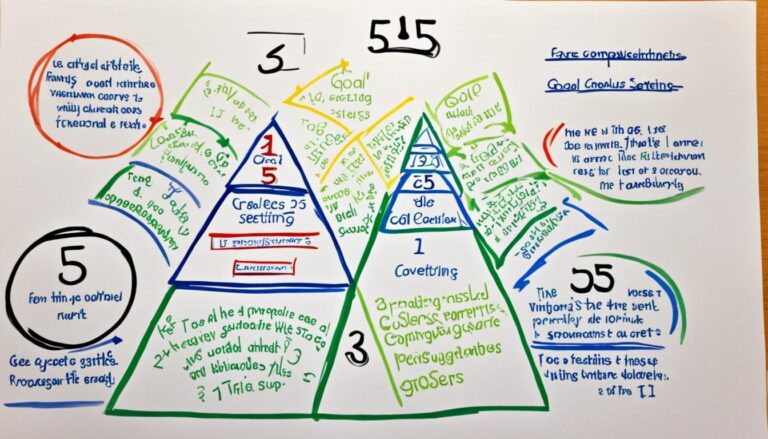Achieve Your Dreams with Our Goal Setting Template

Do you find yourself struggling to turn your dreams into reality? Are you tired of setting goals that never seem to come to fruition? It’s time to take control of your future and unlock your true potential through effective goal setting.
Goal setting is not just about wishful thinking. It is a proven method for success, allowing you to define your aspirations, create actionable plans, and track your progress along the way. But where do you start? How can you ensure that your goals are well-formulated and aligned with your ambitions?
Introducing our comprehensive goal setting template – your ultimate tool for turning dreams into achievements. This goal planning sheet is designed to guide you through the goal-setting process, helping you set SMART (Specific, Measurable, Achievable, Relevant, and Time-Bound) goals that propel you towards the life you’ve always wanted.
With our goal tracker template, you can easily monitor your progress, stay motivated, and make the necessary adjustments to stay on track. Say goodbye to aimless wandering and hello to focused action.
Key Takeaways:
- Effective goal setting is crucial for achieving your dreams and desires.
- Our goal setting template provides a clear roadmap to success.
- Set SMART goals that are specific, measurable, achievable, relevant, and time-bound.
- Track your progress with our goal tracker template to stay motivated and accountable.
- Unlock your true potential and start turning your dreams into reality today.
3 Ways to Set Achievable Goals
When it comes to setting goals, there are different types that you can consider – each with its own unique approach and mindset. By understanding these different types of goals, you can choose the ones that align with your ambitions and aspirations, leading you to success.
Outcome Goals
Outcome goals are the big-picture objectives that you want to achieve in the long run. They represent the ultimate result you desire and provide a clear vision of what success looks like. These goals are often ambitious and serve as a driving force to motivate you throughout your journey. To set meaningful outcome goals, ask yourself:
- What is your ultimate vision?
- What do you want to accomplish in the future?
Performance Goals
Performance goals focus on improving your specific skills or abilities. They are measurable and reflect the level of proficiency you aim to reach in a particular area. Setting performance goals allows you to track your progress and identify areas for improvement. To set effective performance goals, consider:
- Which skills or abilities do you want to develop?
- How will you measure your progress?
Process Goals
Process goals concentrate on the actions and behaviors you need to perform consistently to achieve your desired outcome. These goals break down larger objectives into manageable steps, making your journey more manageable and actionable. To set process goals effectively, think about:
- What actions do you need to take regularly?
- How will you stay accountable to your process goals?
Delivery-Focused Goals
Delivery-focused goals are centered around the successful completion of a specific project or task. They require careful planning and attention to detail to ensure that the desired outcome is achieved efficiently and effectively. To set delivery-focused goals, consider:
- What projects or tasks do you need to complete?
- What is the desired outcome for each of them?
By setting a blend of outcome goals, performance goals, process goals, and delivery-focused goals, you can create a well-rounded goal-setting strategy that keeps you motivated and on track. Remember to choose goals that challenge you and align with your overall life goals. Now, let’s explore some examples of each goal type to help you get started:
| Goal Type | Example |
|---|---|
| Outcome Goal | Run a marathon within one year |
| Performance Goal | Increase sales by 20% in the next quarter |
| Process Goal | Practice playing the guitar for 30 minutes every day |
| Delivery-Focused Goal | Complete the website redesign project by the end of the month |

Our 5 Favorite Goal-Setting Worksheets
Setting goals is an essential step in achieving success and personal growth. To assist you in this process, we have compiled a list of our top five goal-setting worksheets that can provide structure and guidance. These worksheets incorporate various techniques and strategies, including the renowned GROW model, SMART goals, and goal planning. Utilize these resources to define your goals, break them down into actionable steps, and stay motivated throughout your journey.
GROW Model Worksheet
One of our favorite goal-setting frameworks is the GROW model. This model helps individuals outline their goals by assessing their current reality, exploring potential options, and ultimately creating a plan of action. The GROW model worksheet enables you to navigate each stage of the process systematically. By utilizing this worksheet, you can gain clarity on your goals, identify possible obstacles, and develop an effective plan to achieve them.

SMART Goals Worksheet
The SMART goals worksheet is a popular tool that ensures goals are Specific, Measurable, Achievable, Relevant, and Time-bound. This worksheet encourages you to articulate your goals clearly, identify measurable indicators of success, devise actionable steps, and set a deadline for completion. By utilizing the SMART goals worksheet, you can formulate goals that are realistic, attainable, and aligned with your long-term aspirations.
Goal Planning Worksheet
The goal planning worksheet offers a comprehensive framework for setting and planning your goals. This worksheet allows you to define your desired outcomes, break them down into smaller milestones, prioritize tasks, and allocate resources accordingly. By utilizing the goal planning worksheet, you can create a roadmap to navigate your journey effectively and ensure you are making progress towards your goals.
Goal Achievement Strategy Template
The goal achievement strategy template is a valuable tool for outlining your strategy and action plan. This template enables you to identify specific actions, allocate resources, set deadlines, and track your progress. By utilizing the goal achievement strategy template, you can stay organized, stay motivated, and monitor your advancement towards achieving your goals.
Additional Goal-Setting Resources
- Work-Life Balance Worksheet
- Personal Development Plan Template
Table: Our 5 Favorite Goal-Setting Worksheets
| Worksheet | Description |
|---|---|
| GROW Model Worksheet | Utilize the GROW model to define and strategize your goals. |
| SMART Goals Worksheet | Set SMART goals with clear objectives and measurable targets. |
| Goal Planning Worksheet | Create a roadmap by outlining your goals and actionable steps. |
| Goal Achievement Strategy Template | Develop a strategy to achieve your goals and track your progress. |
| Additional Resources | Work-Life Balance Worksheet, Personal Development Plan Template |
Goal-Setting Tools for Therapy and Coaching
Goal setting plays a crucial role in cognitive-behavioral therapy (CBT), helping individuals identify their desired achievements and navigate positive changes in their lives. Therapists and coaches have access to specific goal-setting tools and worksheets that facilitate clients in setting and achieving their therapy goals.
Utilizing Cognitive-Behavioral Therapy (CBT)
Cognitive-behavioral therapy (CBT) focuses on the connection between thoughts, feelings, and behaviors, aiming to foster healthier patterns of thinking and more adaptive behaviors. Establishing therapy goals is an integral part of CBT, enabling individuals to target specific areas for improvement and track their progress throughout the therapeutic process.
To assist therapists and clients in the goal-setting process, various tools and techniques are employed. Here are a few notable examples:
- The Goal-Setting Worksheet: This worksheet provides a structured framework for defining therapy goals. Clients can identify the specific areas they wish to address and outline the steps they need to take to achieve those goals.
- Therapy Goal Planner: This tool helps individuals organize and track their therapy goals, ensuring they remain focused and motivated. It offers a visual representation of progress and can be a valuable resource for discussions during therapy sessions.
By utilizing these goal-setting tools, therapists and clients can collaborate effectively and tailor therapy sessions to address specific concerns and aspirations.
Benefits of Goal Setting in Therapy
Setting goals in therapy offers numerous benefits, including:
- Increased Motivation: Clearly defined goals can serve as a powerful motivator, inspiring individuals to actively participate in their therapy and strive for positive changes.
- Enhanced Focus: Goal setting provides a sense of direction, helping individuals concentrate on the areas they wish to improve. Therapy goals act as a guide, ensuring that sessions and interventions align with the desired outcomes.
- Measurable Progress: Establishing specific and measurable therapy goals allows clients to track their progress objectively, celebrating achievements and identifying areas that require further attention.
- Empowerment: Working toward therapy goals empowers individuals by fostering a sense of control over their personal growth and development. It helps them build confidence and resilience, ultimately leading to improved well-being.
Through effective goal setting, individuals can maximize the benefits of therapy and experience transformative changes in their lives.

2 Templates for CBT and DBT
Cognitive-behavioral therapy (CBT) and dialectical behavior therapy (DBT) are therapeutic approaches that provide individuals with effective tools for personal growth and emotional well-being. To support goal-setting within CBT and DBT, there are dedicated worksheets available that offer structure, guidance, and empowerment.
To help individuals set specific, measurable, achievable, relevant, and time-bound (SMART) goals, here are two goal-setting templates:
1. CBT Goal-Setting Worksheet
The CBT goal-setting worksheet assists individuals in identifying their desired outcomes, exploring potential obstacles, and developing strategies to overcome them. By using this worksheet, you can gain clarity on your goals, prioritize actions, and track progress toward achieving them.

| Goal | Obstacles | Strategies | Progress |
|---|---|---|---|
| Example Goal | Identify and challenge negative thoughts | Practice reframing techniques | In progress |
| Another Goal | Manage stress more effectively | Implement relaxation techniques, set boundaries | In progress |
2. DBT Goal-Setting Worksheet
The DBT goal-setting worksheet focuses on creating balance, improving emotional regulation, and building healthy relationships. This worksheet enables you to define your goals, identify specific behaviors to work on, and track your progress in implementing positive changes.
| Goal | Behaviors | Strategies | Progress |
|---|---|---|---|
| Example Goal | Reduce impulsive reactions | Practice mindfulness, use distress tolerance skills | In progress |
| Another Goal | Improve assertiveness | Develop effective communication techniques | In progress |
By using these CBT and DBT goal-setting worksheets, you can enhance your therapeutic journey, achieve tangible results, and cultivate positive changes in your life.
Worksheets for Teachers and Students
In the field of education, goal setting plays a crucial role in fostering students’ personal growth and academic achievement. For teachers, goal setting helps create a focused and effective learning environment. Whether you’re an educator or a student, using goal-setting worksheets can provide structure, accountability, and motivation on your educational journey.
Goal Setting in Education
Goal setting in education empowers students to take ownership of their learning and personal development. By setting clear objectives and creating actionable plans, students can enhance their academic performance and cultivate important life skills.
- Improve subject-specific knowledge and skills
- Enhance critical thinking and problem-solving abilities
- Develop effective study habits and time management skills
- Expand creativity and self-expression
- Build resilience and perseverance
The process of setting goals also instills students with a growth mindset, emphasizing that their abilities can be developed through dedication and effort. By setting and achieving goals, students gain a sense of accomplishment and confidence in their abilities.
Goal Setting for Students
Teachers often use goal-setting worksheets to guide their students in the goal-setting process. These worksheets provide a framework for students to articulate their aspirations, create action steps, and monitor their progress. They also encourage self-reflection, allowing students to assess their strengths, areas for growth, and personal interests.
Here’s an example of a goal-setting worksheet for students:
| Goal | Action Steps | Deadline | Progress |
|---|---|---|---|
| Improve math grades | Attend tutoring sessions, practice math problems daily | End of the semester | 85% achieved |
| Read 10 books | Create a reading plan, set aside dedicated reading time | End of the school year | 5 books read |
| Participate in a science fair | Choose a topic, conduct research, design an experiment | Spring semester | Project in progress |
Students can use this worksheet to define their goals, outline the steps they need to take, set deadlines, and track their progress along the way. Regularly reviewing and updating the worksheet allows students to stay motivated, make adjustments, and celebrate their achievements.
Goal Setting for Teachers
As educators, setting goals can help you create a dynamic and effective learning environment for your students. By defining your objectives, you can align your teaching strategies, instructional materials, and assessments with the desired outcomes. Goal setting for teachers also promotes professional growth and continuous improvement.
Here’s an example of a goal-setting worksheet for teachers:
| Goal | Action Steps | Deadline | Progress |
|---|---|---|---|
| Incorporate technology into lessons | Attend professional development workshops, explore educational apps | End of the school year | 50% achieved |
| Implement project-based learning | Design project-based units, collaborate with colleagues | Next semester | Planning phase |
| Enhance assessment strategies | Explore alternative assessment methods, attend webinars | End of the school year | Implementation in progress |
This worksheet allows teachers to set goals related to their professional development and classroom practices. By breaking down their goals into actionable steps and tracking their progress, educators can continually improve their teaching methodologies and student outcomes.
The worksheets mentioned here are just a few examples. There are various other goal-setting templates available for teachers and students, each catering to different educational contexts and objectives. By using these resources, both teachers and students can thrive in their educational journey by setting, monitoring, and achieving their goals.
2 Templates for Businesses and Employees
Goal setting plays a crucial role in driving the success of businesses and enhancing employee productivity. By setting clear and specific goals, businesses can align their objectives with their overall mission and vision, creating a roadmap for achievement. Similarly, employees can benefit from setting goals that are in line with their organization’s goals and values, enhancing their performance and contribution to the workplace.
There are various goal-setting templates available for businesses and employees to streamline and structure their goal-setting process. Let’s explore two effective templates below:
1. Business Goal-Setting Template
Businesses can use this goal-setting template to define and track their goals, ensuring they are aligned with their strategic objectives. This template encompasses key elements such as:
- Goal statement: Clearly articulate the desired outcome of the goal.
- Measurable metrics: Identify specific key performance indicators (KPIs) that will gauge progress towards the goal.
- Timeline: Set realistic timelines for goal achievement.
- Action steps: Break down the goal into actionable steps, assigning responsible parties for each task.
2. Employee Goal-Setting Template
Employees can leverage this goal-setting template to establish individual goals that align with the organization’s objectives. This template includes the following components:
- Goal description: Clearly articulate the specific goal the employee aims to achieve.
- Measurable criteria: Define the key indicators to measure progress towards the goal and track success.
- Timeline: Set a realistic timeline for goal accomplishment.
- Development opportunities: Identify any training or skill enhancement needed to achieve the goal.
Using these goal-setting templates, businesses and employees can establish meaningful and measurable goals that drive success and fulfillment in the workplace. These templates provide a structured approach to goal setting, ensuring that objectives are well-defined, actionable, and aligned with organizational priorities.
Conclusion
In conclusion, goal setting is a powerful tool that can significantly contribute to your personal and professional growth. By utilizing well-formulated frameworks and worksheets, such as the GROW model and SMART goals worksheets, you can effectively define your goals, develop actionable plans, and maintain motivation throughout your journey.
No matter the context, whether it’s in therapy, education, or business, goal setting provides a clear roadmap for success. Setting meaningful and challenging goals that align with your overall life goals is key to achieving fulfillment and satisfaction in your pursuits.
However, it’s important to regularly review and adjust your goals to ensure they remain relevant and in line with your evolving aspirations. As you progress, reflect on your achievements, learn from any setbacks, and make necessary adjustments to keep yourself on track towards your desired outcomes.
Remember, goal setting is a continuous process. It requires commitment, perseverance, and the willingness to adapt as you navigate through various stages of your personal and professional life. Embrace goal setting as a valuable tool, and you’ll unlock your potential to achieve remarkable success.






